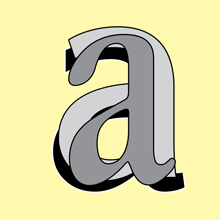Thomas Phinney wrote a thoughtful blog post last week about “The Impact of Steve Jobs on Typography”: about how the Mac pioneered proportional fonts on the screen, and how the combination of Aldus PageMaker and the LaserWriter created desktop publishing; and about a host of later improvements and developments: “Being able to see what fonts look like on screen. Showing proportional fonts on screen. Scaling the same font outlines for screen as for print. Putting a ‘font’ menu in applications, and having all applications share a pool of fonts installed at the system level (instead of associated with some specific printer).” Jobs was famously attentive to details; more to the point, he was famously attentive to the details of design. His flare and care for industrial design made Apple’s products desirable – and usable.
Which is why I’ve always been disappointed that Apple doesn’t bring that same level of perfectionism to its use of type. The graphic design, both in Apple’s marketing and in its products themselves, is always careful and clean; but the choices of fonts have been erratic, and they’re not always used consistently. Just looking at a current page of the Apple website, about Mac products, I see both their corporate font, Myriad, and the current Mac user-interface font, Lucida Grande. Both are well-designed humanist sans-serif typefaces, and either one works well; they actually play together better than you would think, but it’s still subtly jarring to see two competing sans serifs on the same page. But that’s not all.
Ever since the introduction of the iPhone, Apple has been moving toward using versions of Helvetica on screen. I’ve written before about the problem with reading numbers in Helvetica. The same repetition of shapes that makes Helvetica look consistent and “modern” (or at least retro-modern) creates ambiguity and makes it all too easy to mistake one number or letter for another. As Thomas Phinney said in a comment on his own post, “I love iOS, but I am still horrified that it uses Helvetica as a UI font.”

